Bird Feeding
Are you one of the 59 million people who feed birds? If yes, you are involved in the second most...


If you set out bird feeders, you are not alone. The US Fish and Wildlife Service estimates that there are 50 – 60 million people who feed birds. That is around 50% of households. They spend a total of around $4 billion on bird food annually. That buys 1 billion pounds (500,000 tons) of seeds, suet, and other types of bird food.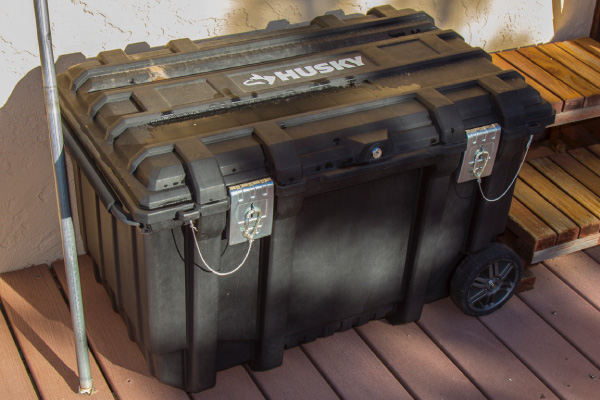
A "Bear Box" bolted to my deck and locked with carabiners protect my feeders at night when bears are on the prowl.
Why do people get into bird feeding? Most people say they enjoy watching nature and enjoy the sound of birds in their yard. Some do it because they want to help birds. Others wish to learn bird behavior and also learn how to identify them. Some parents want to provide an educational experience for their children. I have also spent a lot of time photographing birds at my feeders. To date I have photographed 32 different species of birds.
What birds are the winter locals? Juncos, downy and hairy woodpeckers, chickadees, siskins, grosbeaks, finches, jays, nuthatches, and more tough it out during our long winters. Snow may bury a lot of the food that these birds use, so the seed people put out can get them through those tough times.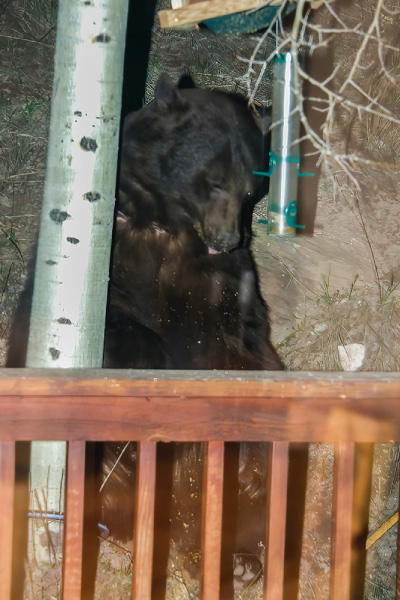
This black bear climbed an aspen to tear down some bird feeders that were 10 feet off the ground.
There are some bird-feeding mistakes that people my make. You definitely want to buy seed that is desired by the local birds. The birds that stay through the winter may desire seeds that the migrants might ignore. Bird seed marketed for the East may not have as much nutrition as seed specific to the Mountain West. Don’t buy mixed seed that has a lot filler. Cheap bags of bird seed may contain things like milo, oats, flax, canary seed, wheat, or cracked corn that is not appealing to many birds in the mountains of Colorado.
For mixed seed, look for products that have black-oil sunflower seeds, Nyger or thistle seed, peanuts, safflower and white proso millet. Buy it in large bags to save some money and keep a good supply on hand to refill your feeders.
What do the locals like?
Sunflower seeds – chickadees, finches, jays
Peanuts -- jays
White proso millet -- juncos, sparrows, and mourning doves
Nyjer seed -- pine siskins and some finches.
Suet cakes -- northern flickers and woodpeckers
Trees near feeders provide cover and protection for birds like this finch that visit your feeders.
Black oil sunflower seed is a favorite for many birds due to it having a high oil content. Some specialty stores have a no-shell blend of sunflower seed so that the mess on your deck under the feeder is not so great. Some people also put out raisins, tree nuts, and peanuts in the shell.
What feeders are the best? Go into a wild bird store or do a search on Google and you will see an amazing array of different shapes and sizes of bird feeders. Having feeders of different types will attract different varieties of birds. A hopper feeder or flat feeder along with a tube feeder is a good combination. Place them in separate areas to attract more birds. Many of these feeders are designed for specific kinds of bird seed or to attract specific kinds of birds. That information is often on the labels of the product.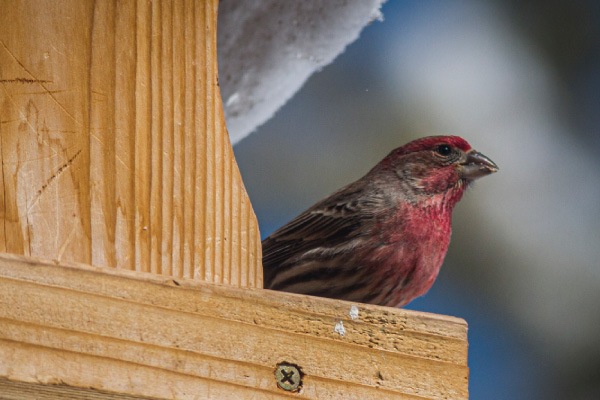
Bird feeders that have screens under the seed will be cleaner and dryer than feeders with solid bottoms.
Some people want feeders that have trays to catch spilled seed. That is not really necessary because a lot of birds will clean it up because they prefer feeding on the ground. This may, however, attract squirrels, chipmunks, rabbits, which might attract coyotes or foxes.
Two things to consider when putting out the feeder. You will enjoy them more, if they are mounted where you can see them easily. Avoid placing them too close to your windows. Startled birds will often hit the glass and may be injured or killed. Putting decals on windows may help to prevent this. Putting feeders near trees and shrubs will also allow the birds places to go for cover and protection from the elements and predators.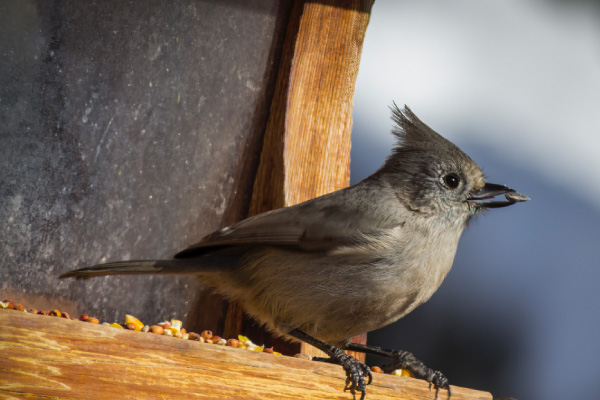
Feeders may allow you to identify birds that may not be commonly seen, like this juniper titmouse.
Pick large feeders so you don’t have to fill them as often. Larger feeders are also easier to clean. Flat feeders and house feeders that have screen bottoms stay cleaner and do not retain moisture that can damage the seed. Clean the feeders regularly to prevent conditions that could be unsanitary and lead to health problems for the birds.
Whatever feeders you choose, keep them full. If you are gone and they go empty for a day or two it will not be a big problem. However, birds will begin to ignore feeders that are not filled consistently.
Does feeding birds have a detrimental impact on populations or the health of birds? We have been told not to feed just about every other type of wild animal. Feeding wildlife can cause them to stray from their natural habits. It may make them dependent upon human provided food rather than natural foods. Feeding wildlife is against the law. Why should the birds be different?
Feeding birds is generally not against the law, though some local governments may prohibit it.
The winter months can be difficult and in extreme weather the birds may benefit greatly from the extra calories people provide with feeders. Snowstorms and periods of icy weather can limit available food. Bird feeders provide a supplement to their diets. Birds still find dormant insects in the bark of trees and will also find food in other environments.
We have built up the areas where birds fed historically before man. Buildings, roads, and parking lots have removed a lot of the natural habitat. In addition, stray and wandering house cats that come into this environment kill millions of birds every year. Does bird feeding have a way of making up for that?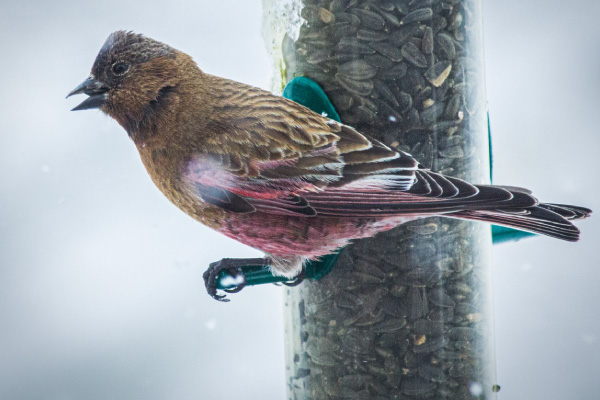
Tube feeders are good for sunflower seeds.
There are many people that believe that bird feeders may do harm to wild birds. They believe that when birds are attracted to feeders they congregate in large numbers and that is detrimental on a lot of fronts.
Feeders will attract squirrels, chipmunks, rats, raccoons, skunks, and even deer. That attracts predators like foxes, bobcats, bears and mt. lions. All of that can actually reduce the overall population of birds and attract bears and Mt. Lions can cause other kinds of problems. The animals that become adapted to living with people are increasing in numbers.
They also believe that bird feeders lure birds to houses where they die after flying into windows. Higher populations near cities and homes cause deaths as they fly into skyscrapers or cars.
A bird feeder brings animals in close proximity, and this can spread illness. Conjunctivitis, an eye and respiratory disease, has been spread virtually nationwide through feeders infected by the bacterium. The disease causes the birds' eyes to get encrusted and swell shut. Unable to see, the birds die of starvation or predation.
Bacteria and mold can form on old or damp seed, causing a loss of weight in birds and they may have difficulty breathing and walking. Bird feces under feeders sometimes contain parasites and bacteria that infect ground-feeding birds.
The Cornell Lab of Ornithology uses the nearly 30 years of Project FeederWatch, Great Backyard Bird Count, and Christmas Bird Count data to examine if feeding birds is harmful. There are many research projects to determine what impact feeders have on bird populations and other animals that may be attracted to the area. No research has yet proven that it is detrimental overall.
The greatest impact on the health of birds is habitat loss. As an example, they found that for Pinyon Jays, the most pressing problem is the destruction of pinyon pine habitat. According to the State of the Birds report, the species of birds that are in the most trouble are seabirds, shorebirds, and tropical forest dwellers. Bird feeders do not impact those species.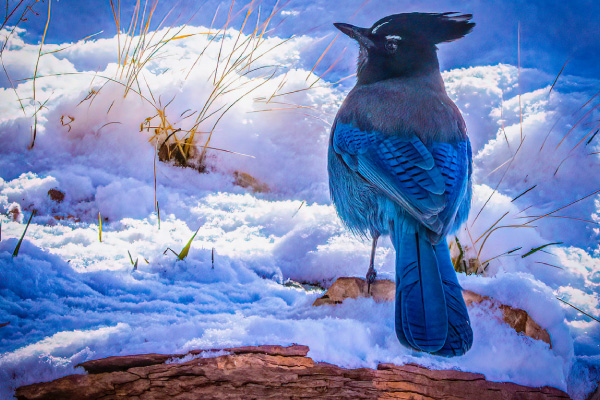
Stellars jays and other birds will often clean up seed that is spilled on the ground.
From early spring to early winter it is a good idea to bring in feeders at night. Bears will tear down trees, poles, and posts to get to bird seed. Broken pieces from damaged plastic feeders may cause digestive issues for bears.
I keep bird seed and feeders in a “Bear Box” at night. It is a large Husky brand toolbox that is bolted to my deck. It has two carabiners that lock it up. There are bear claw scratches on the box, but bears have never gotten into it.
If you put out feeders, try to do all you can to have a positive impact on birds and prevent the issues that can arise. Provide food that is nutritious & desirable, clean feeders regularly, avoid putting feeders too close to your windows and from early spring to early winter - don't leave feeders out overnight.
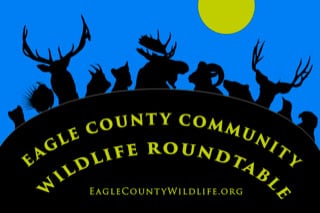 The Eagle County Community Wildlife Roundtable is a collaborative partnership with the White River National Forest, Colorado Parks and Wildlife, Bureau of Land Management, local government entities, community members, and citizen scientists. The purpose of the Eagle County Community Wildlife Roundtable is to gather a group of diverse stakeholders in the valley to understand and address issues facing wildlife populations. Together we will identify a shared vision and realistic actions that the community can rally around to support wildlife. We want to leverage diverse values, creativity, and resources to move toward positive action.
The Eagle County Community Wildlife Roundtable is a collaborative partnership with the White River National Forest, Colorado Parks and Wildlife, Bureau of Land Management, local government entities, community members, and citizen scientists. The purpose of the Eagle County Community Wildlife Roundtable is to gather a group of diverse stakeholders in the valley to understand and address issues facing wildlife populations. Together we will identify a shared vision and realistic actions that the community can rally around to support wildlife. We want to leverage diverse values, creativity, and resources to move toward positive action.

Rick Spitzer is the author of the article and official photographer for Eagle County Community Wildlife Roundtable.
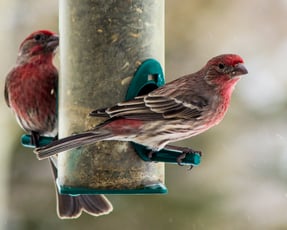

Are you one of the 59 million people who feed birds? If yes, you are involved in the second most...
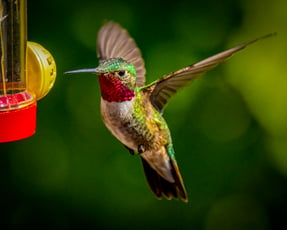

Birds are a significant part of the wildlife in the ecosystems of Eagle County and around the...